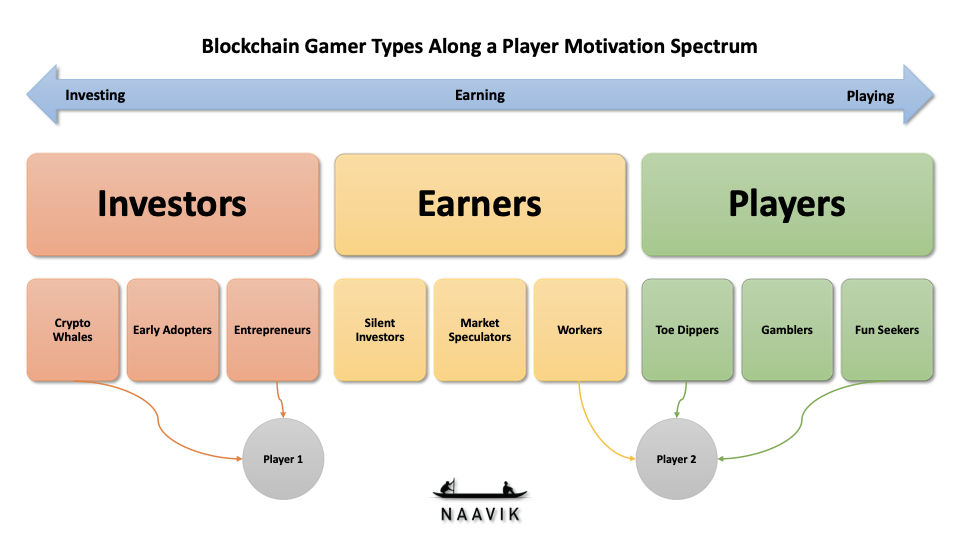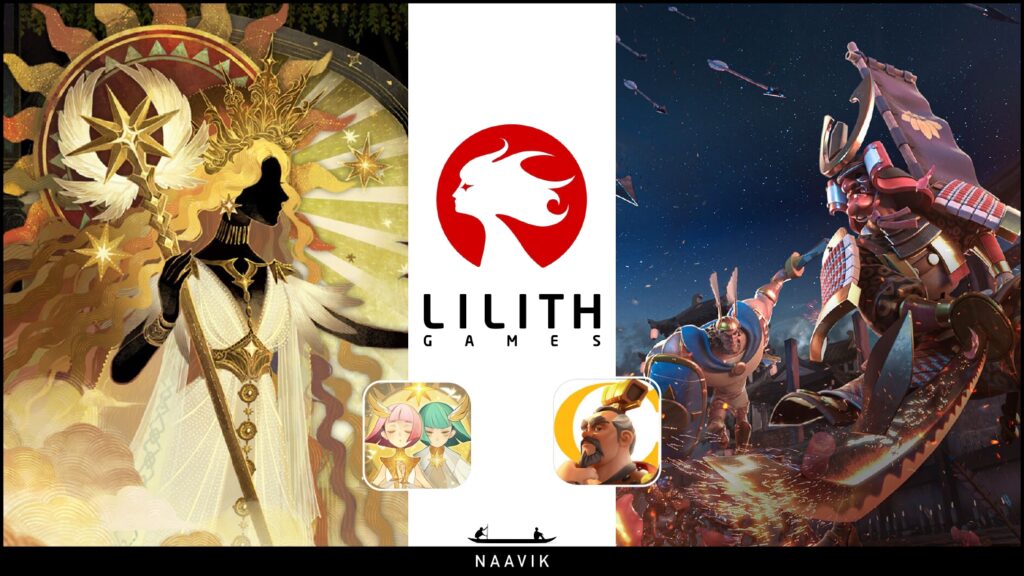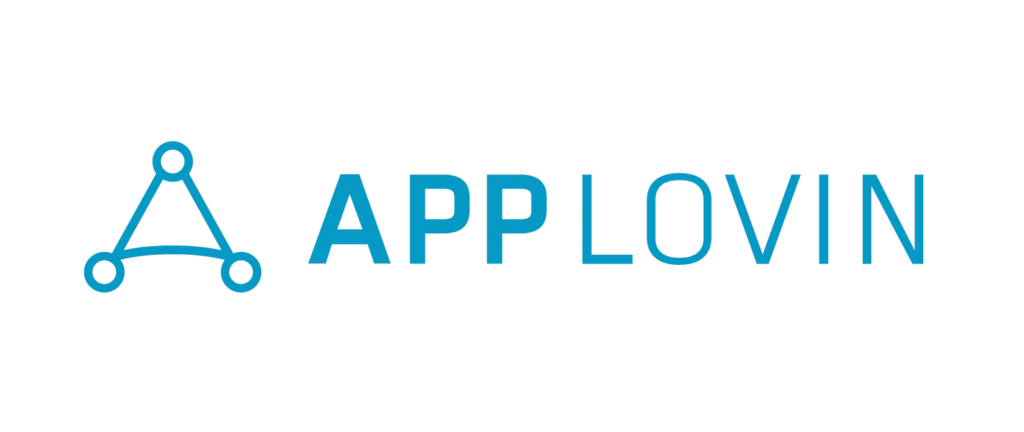Hi Everyone. Last Sunday’s most popular links included: details behind Netflix's new gaming line-up, the announcement of Kevin Lin's new game studio, and GI.Biz's piece on the hype behind NFTs. With that, let’s dive into today’s issue.
From The Archives: Into The Void - Where Crypto Meets the Metaverse
Earlier this year, Piers Kicks from Delphi Digital collaborated with Master The Meta to write a brilliant essay that may alter your worldview. The piece covers the internet of tomorrow, why crypto has an imperative role to play in it, how digital economies will transform as a result, and what this all ultimately means for the gaming industry (and beyond). He wraps up with takeaways for companies, entrepreneurs, and investors. We learned a ton from this piece and expect you will too - enjoy!
#1: The 9 Types of Blockchain Gamers
Source: Hackernoon
According to Wikipedia and based on a 1996 paper by Richard Bartle, the Bartle taxonomy of player types is a classification of video game players according to their preferred actions and/or motivations within the game. To Bartle’s credit, his player type taxonomy continues to be relevant today. But Bartle’s taxonomy was also built in a time when blockchain gaming was unheard of, and aligned for game design contexts that plainly did not encompass play-to-earn as a concept.
We recently worked with WarnerMedia to understand whether different types of blockchain gamers with distinct motivations to play blockchain games also exist. This analysis is based on publicly available developer interviews, our work with blockchain games, WarnerMedia’s pre-existing research in the space and some assumptions. While we don’t claim our findings to rival that of the prolific Bartle, here is our attempt to better understand a non-mutually exclusive set of blockchain gamer types that are differentiated across a motivation spectrum of Investing ↔ Earning ↔ Playing.
There are two player types that are important to impacting a blockchain game’s economic ecosystem, but we won’t cover in this model - Influencers and Disruptors. | Source: Naavik Research
The nine blockchain gamer types showcased above are a function of a player’s driving motivations to engage with blockchain games. Therefore, we expect players to have a mix of motivations when playing blockchain games, and conversely believe that “pure players” (players who are 100% of one type) are going to be rare. Of that motivational mix, some motivations will be dominant engagement drivers, while the rest are weaker yet relevant player pursuits. For example, a player could be a dominant Crypto Whale, but could also enjoy being an occasional Toe Dipper or Fun Seeker for a certain game.
Let’s further break down each of the types based on - factors that truly define them, their key motivations to engage with the blockchain game, what kinds of on-chain assets they usually interact with, and how one can go about acquiring and retaining them. While the first three points help outline a persona, the last two points tackle how a game team can take action on that persona.
Types of Investors
#1 Crypto Whales:
-
Defining Factor: Usually possess large, liquid, deployable funds at hand - for example, various kinds of financial institutions.
-
Key Motivation: To gain influence/power in a new blockchain game early - the earlier, the better.
-
Key Asset Activity: Holding governance or gameplay tokens/NFTs early, such as during private sale rounds.
-
Acquisition Strategy: Game teams usually end up seeking them out since the project usually hasn’t reached critical mass by that point, but this type also could proactively reach out.
-
Retention Strategy: The more they see a path to their purchased tokens/NFTs accruing significant value in the long term, the more they will retain (hold their assets).
#2 Early Adopters:
-
Defining Factor:
-
Might not have a comparable fund liquidity volume to that of Crypto Whales, but they get to know about projects early and do their research well.
-
They are critical to a game’s initial traction, as they usually are initial evangelists in broader communities - for example, some influencers or thought leaders.
-
-
Key Motivation: To get invested early and benefit from potential hockey-stick growth.
-
Key Asset Activity: Purchasing collectible NFTs or NFTs with convincing in-game utility.
-
Acquisition Strategy: Since they’re usually in the know about upcoming blockchain gaming projects through various online channels, being top of mind through similar channels is key.
-
Retention Strategy:
-
They will be the earliest community members, so continue to build trust early with them and the community at large over time.
-
They will keep a close eye on various launch/operational activities that contribute to increasing owned asset value over time, such as launching a game’s active trading marketplace, so keep the asset value gain treadmill running.
-
#3 Entrepreneurs:
-
Defining Factor: Have a deep understanding of the game’s economy, and set up shop within the game to serve a particular audience by creating value for them - for example, Sponsors in Axie Infinity.
-
Key Motivation: To maximise the number of passive income streams that scales with the number of players who “work” for them through using their assets.
-
Key Asset Activity: Purchasing in-game assets that can either be lent out to or be earned by other players.
-
Acquisition Strategy:
-
They need to be convinced that the target game has enough depth, asset variety and inherent asset value to justify their existence in the economy.
-
The game team also needs to roll out the red carpet in terms of wallet/account management support to facilitate the special needs of such players and reduce their onboarding overhead.
-
-
Retention Strategy:
-
Continuing to ensure a strong relationship with the game team over time, as the existence of these players allows various Earner types to exist.
-
Making sure the game has a healthy economy and steady inflow of new players, who could act as new recruits for the Entrepreneurs.
-
Types of Earners
#1 Silent Investors:
-
Defining Factor:
-
They are usually more immersed into crypto vs the games themselves and hold a portfolio of assets across many games - for example, hedge/token funds buying very rare/expensive game specific NFTs.
-
They usually just hold assets and play a passive role long-term, which results in their activity not amounting to much of the daily transaction volume.
-
-
Key Motivation: To invest into the right game projects, spread investment risk through asset diversification, and flip/profit over the longer-term.
-
Key Asset Activity: Purchasing collectible NFTs or NFTs with promised/solid in-game utility.
-
Acquisition Strategy: They generally gravitate towards games with proven/healthy economies and a diverse range of tradable assets.
-
Retention Strategy: They will keep a close eye on various launch/operational activities that contribute to increasing owned asset value over time.
#2 Market Speculators:
-
Defining Factor:
-
They are usually high frequency asset traders that benefit from volatility, but also help with stabilizing asset prices and/or acting as market makers.
-
They could be of two types - Arbitragers (use market volatility to profit) or Pure Speculators (bet on/against future asset demand/supply).
-
-
Key Motivation: To maximise profits in the shortest possible time frame by flipping and scalping.
-
Key Asset Activity: Any purchasable on-chain item is on their radar.
-
Acquisition Strategy: They’re naturally attracted to games with vibrant and/or volatile economies.
-
Retention Strategy:
-
They prefer games with healthy and somewhat predictable live-ops, so that bets can be made with more conviction and justification.
-
They crave access to detailed information about the future of the project, such as product roadmaps, feature launch timelines, design details etc.
-
#3 Workers:
-
Defining Factor: They generally stem from lower-income nations and are time-rich vs cash-rich - for example, Scholars in Axie Infinity.
-
Key Motivation: To create an alternative or additional source of daily income.
-
Key Asset Activity: Whatever on-chain assets Entrepreneurs are willing to lend out.
-
Acquisition Strategy: They usually need to see proof that earning through the game is sustainable long-term and potentially a better option than their daily wage job - both of which result in less opportunity cost risk for them.
-
Retention Strategy: As long as the game possesses a healthy economy with asset prices that justify the opportunity cost of not performing a daily wage job versus playing-to-earn, they will retain - this is why the D90 retention of Axie Infinity is equal to its D30, since Scholars are earning money every day from the game and not really “playing”.
Types of Players
#1 Toe Dippers:
-
Defining Factor:
-
Typically very new to blockchain gaming, and therefore need to be handled with care - for example, casual mobile gamers that have a high early churn potential due to UX complexities attached to blockchain gaming.
-
Generally need low entry barriers or other ways to participate in the game/economy.
-
Like to jump into games that have a proven reputation, and their chance of sticking around depends on the economic investment they made into the game.
-
Generally willing to convert into economically invested players, but also susceptible to scammers due to lack of education about the space.
-
-
Key Motivation: To learn about P2E, start earning, and potentially gravitate towards one of the other player types.
-
Key Asset Activity: The basic minimum assets they need to start playing, which could also be no assets.
-
Acquisition Strategy:
-
They naturally gravitate towards games that are being talked about in various social circles and/or games with a good reputation.
-
It would be key to ensure low entry barriers, so that time between first touch and first in-game action is minimised as much as possible.
-
-
Retention Strategy: An easy on-ramp to the game/crypto experience and a healthy community are strong drivers to keep them around long-enough before they convert into one of the other player types.
#2 Gamblers:
-
Defining Factor:
-
They generally don’t have the deep understanding of how the game economy works, but have the spending propensity to bet/gamble for profits.
-
Their willingness to invest depends on the fairness of the system and the efficacy that players have on the outcome of their bet.
-
-
Key Motivation: To feel and value from the rush of gambling, on-chain.
-
Key Asset Activity: Whatever they need to play.
-
Acquisition Strategy: Depth of gameplay systems that communicate a potential to attain gameplay mastery through skill is quite important to such players, so that they feel like they have more control on the outcome of their bets.
-
Retention Strategy: A healthy economy with low volatility is key, so that more predictability is brought to their gambling equation.
#3 Fun Seekers:
-
Defining Factor: They’re the closest to the traditional player or broad casual mobile gamers, who actually play for the game’s fun factor, while the potential to earn through playing is just a cherry on the cake.
-
Key Motivation: To play a fun game first.
-
Key Asset Activity: Whatever they need to play, though high price entry barriers can deter.
-
Acquisition Strategy: A game with a great reputation for its gameplay, not its economy.
-
Retention Strategy:
-
Great gameplay that communicates fun first and finance second is the strongest retainer.
-
A generally fair gameplay experience that is not negatively influenced by money-rich players playing in the same ecosystem.
-
All in all, it would be premature for us to say that the above is a complete player type/motivation classification, since blockchain/play-to-earn gaming is really in its infancy and we all continue to learn more and more every day. But we hope the above thought framework helps put some structure around your target audience and player motivation conversations while you continue to build the future of play-to-earn. If you’d like to learn more or need help thinking through this framework (including the two hidden player types), do reach out! (Written by Abhimanyu Kumar. Design research performed by Philipp Zupke and in collaboration with Yang Adija, Matt McElroy and Michael Tai of WarnerMedia.)
Sponsored by Growth Fullstack
Turn your data into powerful insights - Free Trial!
“Game developers need help to make sense of the post-IDFA world of mobile marketing." - Hernan Zhou, CTO, Lucky Kat Studios
Growth FullStack does just this - helping developers and mobile marketers navigate the privacy-first marketing landscape - without expensive data science.
-
Simply collect the data that you need (from sources such as SKAdNetwork, AppLovin, and many others);
-
Store it in the way you want (using platforms like Google BigQuery, Amazon S3 and others);
-
Gain insights via an intuitive dashboard built on top of the data (such as Metabase, Tableau and others);
And optimize your campaigns activity using off-the-shelf or custom analyses.
Growth FullStack offers affordable insights via a no-code, plug-and-play model that lets you get back to making great games and apps.
📚 Content Worth Consuming
Jacob Navok: Computing and Network Needs of the Metaverse (Hello Metaverse): “Beyond the buzz around what kinds of new use cases and consumer experiences the Metaverse will enable, it’s important to think about the foundations. What is the infrastructure and computing power we will need to actually power this future? This is not something that will be solved by any company alone, but a collective effort of all the builders of the internet.” Link
An Interview with Cory Strassburger & Blu (Tomorrow with Rovio): “Cory Strassburger drew from an impressive background in film, VFX and motion graphics to become a pioneer in the AR and VR field. Cory created a motion capture technology that allows him to bring a metahuman avatar to life in a YouTube series called Xanadu. Join Cory - and his metahuman alter-ego character Blu - as he shares his thoughts on the metaverse, the next steps in AR/VR tech, and the future of immersive experiences in entertainment.” Link
An Interview with Chris Dixon and Naval Ravikant (The Tim Ferriss Show): “The Wonders of Web3, How to Pick the Right Hill to Climb, Finding the Right Amount of Crypto Regulation, Friends with Benefits, and the Untapped Potential of NFTs.” Link
🔥 Featured Jobs
-
Virtex: Partnerships Director (Remote, Global)
-
BebopBee: Community + Player Experience Manager (Menlo Park, CA)
-
Immutable: BD Exec, Gaming (Remote, US/EU)
-
Ubisoft: Junior Technical Artist (Bucharest, Romania)
-
Hypixel: Senior Game Designer (Remote, Global)
-
Piepacker: Tech Director (Remote, EU)
-
Playco: Financial Planning & Analysis Consultant (Remote, US)
You can view our entire job board — all of the open roles, as well as the ability to post new roles — below.
Thanks for reading, and see you next week! As always, if you have feedback let us know here.












